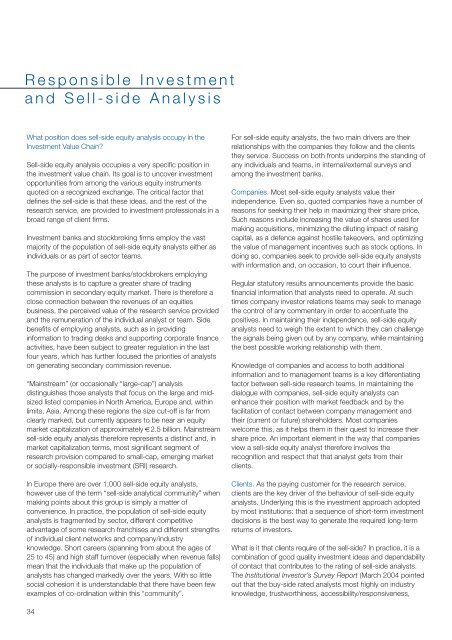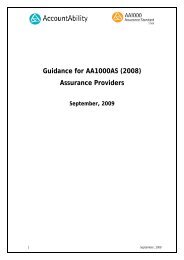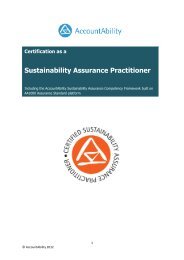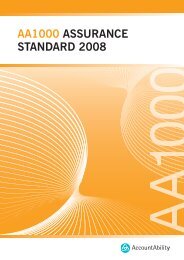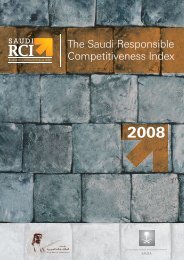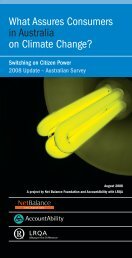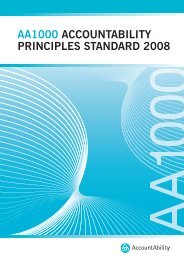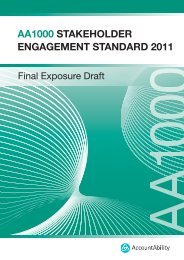Mainstreaming Responsible Investment - AccountAbility
Mainstreaming Responsible Investment - AccountAbility
Mainstreaming Responsible Investment - AccountAbility
Create successful ePaper yourself
Turn your PDF publications into a flip-book with our unique Google optimized e-Paper software.
<strong>Responsible</strong> <strong>Investment</strong><br />
and Sell-side Analysis<br />
What position does sell-side equity analysis occupy in the<br />
<strong>Investment</strong> Value Chain<br />
Sell-side equity analysis occupies a very specific position in<br />
the investment value chain. Its goal is to uncover investment<br />
opportunities from among the various equity instruments<br />
quoted on a recognized exchange. The critical factor that<br />
defines the sell-side is that these ideas, and the rest of the<br />
research service, are provided to investment professionals in a<br />
broad range of client firms.<br />
<strong>Investment</strong> banks and stockbroking firms employ the vast<br />
majority of the population of sell-side equity analysts either as<br />
individuals or as part of sector teams.<br />
The purpose of investment banks/stockbrokers employing<br />
these analysts is to capture a greater share of trading<br />
commission in secondary equity market. There is therefore a<br />
close connection between the revenues of an equities<br />
business, the perceived value of the research service provided<br />
and the remuneration of the individual analyst or team. Side<br />
benefits of employing analysts, such as in providing<br />
information to trading desks and supporting corporate finance<br />
activities, have been subject to greater regulation in the last<br />
four years, which has further focused the priorities of analysts<br />
on generating secondary commission revenue.<br />
“Mainstream” (or occasionally “large-cap”) analysis<br />
distinguishes those analysts that focus on the large and midsized<br />
listed companies in North America, Europe and, within<br />
limits, Asia. Among these regions the size cut-off is far from<br />
clearly marked, but currently appears to be near an equity<br />
market capitalization of approximately €2.5 billion. Mainstream<br />
sell-side equity analysis therefore represents a distinct and, in<br />
market capitalization terms, most significant segment of<br />
research provision compared to small-cap, emerging market<br />
or socially-responsible investment (SRI) research.<br />
In Europe there are over 1,000 sell-side equity analysts,<br />
however use of the term “sell-side analytical community” when<br />
making points about this group is simply a matter of<br />
convenience. In practice, the population of sell-side equity<br />
analysts is fragmented by sector, different competitive<br />
advantage of some research franchises and different strengths<br />
of individual client networks and company/industry<br />
knowledge. Short careers (spanning from about the ages of<br />
25 to 45) and high staff turnover (especially when revenue falls)<br />
mean that the individuals that make up the population of<br />
analysts has changed markedly over the years. With so little<br />
social cohesion it is understandable that there have been few<br />
examples of co-ordination within this “community”.<br />
For sell-side equity analysts, the two main drivers are their<br />
relationships with the companies they follow and the clients<br />
they service. Success on both fronts underpins the standing of<br />
any individuals and teams, in internal/external surveys and<br />
among the investment banks.<br />
Companies. Most sell-side equity analysts value their<br />
independence. Even so, quoted companies have a number of<br />
reasons for seeking their help in maximizing their share price.<br />
Such reasons include increasing the value of shares used for<br />
making acquisitions, minimizing the diluting impact of raising<br />
capital, as a defence against hostile takeovers, and optimizing<br />
the value of management incentives such as stock options. In<br />
doing so, companies seek to provide sell-side equity analysts<br />
with information and, on occasion, to court their influence.<br />
Regular statutory results announcements provide the basic<br />
financial information that analysts need to operate. At such<br />
times company investor relations teams may seek to manage<br />
the control of any commentary in order to accentuate the<br />
positives. In maintaining their independence, sell-side equity<br />
analysts need to weigh the extent to which they can challenge<br />
the signals being given out by any company, while maintaining<br />
the best possible working relationship with them.<br />
Knowledge of companies and access to both additional<br />
information and to management teams is a key differentiating<br />
factor between sell-side research teams. In maintaining the<br />
dialogue with companies, sell-side equity analysts can<br />
enhance their position with market feedback and by the<br />
facilitation of contact between company management and<br />
their (current or future) shareholders. Most companies<br />
welcome this, as it helps them in their quest to increase their<br />
share price. An important element in the way that companies<br />
view a sell-side equity analyst therefore involves the<br />
recognition and respect that that analyst gets from their<br />
clients.<br />
Clients. As the paying customer for the research service,<br />
clients are the key driver of the behaviour of sell-side equity<br />
analysts. Underlying this is the investment approach adopted<br />
by most institutions: that a sequence of short-term investment<br />
decisions is the best way to generate the required long-term<br />
returns of investors.<br />
What is it that clients require of the sell-side In practice, it is a<br />
combination of good quality investment ideas and dependability<br />
of contact that contributes to the rating of sell-side analysts.<br />
The Institutional Investor’s Survey Report (March 2004 pointed<br />
out that the buy-side rated analysts most highly on industry<br />
knowledge, trustworthiness, accessibility/responsiveness,<br />
34


